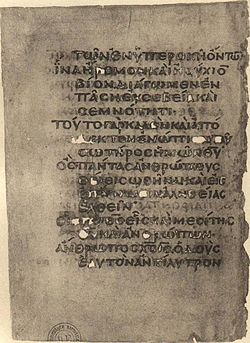1 Timothy 2
Appearance
| 1 Timothy 2 | |
|---|---|
 Fragments showing 1 Timothy 2:2–6 on Codex Coislinianus, from ca. AD 550. | |
| Book | First Epistle to Timothy |
| Category | Pauline epistles |
| Christian Bible part | New Testament |
| Order in the Christian part | 15 |
1 Timothy 2 is the second chapter of the First Epistle to Timothy in the New Testament of the Christian Bible. The author has been traditionally identified as Paul the Apostle since as early as AD 180,[1][2][3] although most modern scholars consider the letter pseudepigraphical,[4] perhaps written as late as the first half of the second century AD.[5]
Text
The original text was written in Koine Greek. This chapter is divided into 15 verses.
Textual witnesses
Some early manuscripts containing the text of this chapter are:
- Codex Sinaiticus (AD 330–360)
- Codex Alexandrinus (400–440)
- Codex Freerianus (c. 450; extant verses 1, 9–13)
- Codex Claromontanus (c. 550)
- Codex Coislinianus (c. 550)
Instruction on Prayer (2:1–7)
Verses 3–4
- 3For this is good and acceptable in the sight of God our Savior, 4who desires all men to be saved and to come to the knowledge of the truth.[6]
- "Savior" (Greek: Σωτῆρος, Sōtēros): The second of three times in this letter (others: 1:1; 4:10) that God is called "Savior", recalling the 'well-known appellation of Yahweh in the Greek Old Testament' (for examples, LXX Deuteronomy 32:15; Psalm 23:5; 24:5; 27:9; 41:6; Isaiah 12:2; 17:10; 43:3; 60:16).[7]
Men and Women at Prayer (2:8–15; 3:1)
Verse 12
- And I do not permit a woman to teach or to have authority over a man, but to be in silence.[8]
- "I do not permit a woman to teach" (KJV: "But I suffer not a woman to teach"): John Gill interprets this in the sense of women may teach only in private, that is, in their own houses and families, to bring up their children in the nurture and admonition of the Lord, not to forsake the law or doctrine of a mother, any more than the instruction of a father (see Proverbs 1:8; 31:1–4), and they are to be teachers of good things (cf. Titus 2:3).[9] Timothy surely received a lot of advantage from the private teachings and instructions of his mother Eunice, and grandmother Lois, but then women were not to teach in the church.[9]
- "To have authority over a man" (KJV: "to usurp authority over the man"): Gill sees this as not to be done in civil and political things, or in things relating to civil government; and in things domestic, or the affairs of the family, therefore also not in ecclesiastical things, nor what relate to the church, for one part of rule is to feed the church with knowledge and understanding; and for a woman to do this, can be seen as to usurp an authority over the man.[9]
- "To be in silence": according to Gill is "to sit and hear quietly", learning, not teaching, as in 1 Timothy 2:11.[9]
Verse 13
- For Adam was formed first, then Eve.[10]
- "Was formed" (Greek: ἐπλάσθη): having the same root as the word used in the LXX in Genesis 2:7, Ἔπλασεν ὁ Θεὸς τὸν ἄνθρωπον, "The Lord God formed man...;" and in Genesis 2:19 of the beasts of the field, wherease in Romans 9:20 man is called τὸ πλάσμα, "the thing made;" and God is ὁ Πλάσας, "he that made it;" the words "plaster", "plastic", or "protoplasm" are also from the same root.[11]
See also
- Adam and Eve
- Crucifixion of Jesus
- Jesus Christ
- Nativity of Jesus
- Related Bible parts: Genesis 2, Genesis 3, Galatians 6, Hebrews 4, Hebrews 7, Hebrews 8
References
- ^ See the arguments on composition of the epistle.
- ^ Halley, Henry H. Halley's Bible Handbook: an abbreviated Bible commentary. 24th edition. Zondervan Publishing House. 1965. p. 631
- ^ Holman Illustrated Bible Handbook. Holman Bible Publishers, Nashville, Tennessee. 2012.
- ^ David E. Aune, ed., The Blackwell Companion to The New Testament (Malden, MA: Wiley-Blackwell, 2010), 9: "While seven of the letters attributed to Paul are almost universally accepted as authentic (Romans, 1 and 2 Corinthians, Galatians, Philippians, 1 Thessalonians, Philemon), four are just as widely judged to be pseudepigraphical, i.e. written by unknown authors under Paul's name: Ephesians and the Pastorals (1 and 2 Timothy and Titus)."
- ^ Stephen L. Harris, The New Testament: A Student's Introduction, 4th ed. (New York: McGraw-Hill, 2001), 366.
- ^ 1 Timothy 2:3–4 NKJV
- ^ Towner 2006, p. 96.
- ^ 1 Timothy 2:12 NKJV
- ^ a b c d "1 Timothy 2:12 - Meaning and Commentary on Bible Verse". biblestudytools.com.
- ^ 1 Timothy 2:13 NKJV
- ^ Exell, Joseph S.; Spence-Jones, Henry Donald Maurice (Editors). On "1 Timothy 2". In: The Pulpit Commentary. 23 volumes. First publication: 1890. Accessed 24 April 2018.
Sources
- Towner, Philip H. (2006). Bruce, Frederick Fyvie (ed.). The Letters to Timothy and Titus. The New International Commentary on the New Testament. Wm. B. Eerdmans Publishing. ISBN 9780802825131.
External links
- 1 Timothy 2 King James Bible - Wikisource
- English Translation with Parallel Latin Vulgate
- Online Bible at GospelHall.org (ESV, KJV, Darby, American Standard Version, Bible in Basic English)
- Multiple bible versions at Bible Gateway (NKJV, NIV, NRSV etc.)
